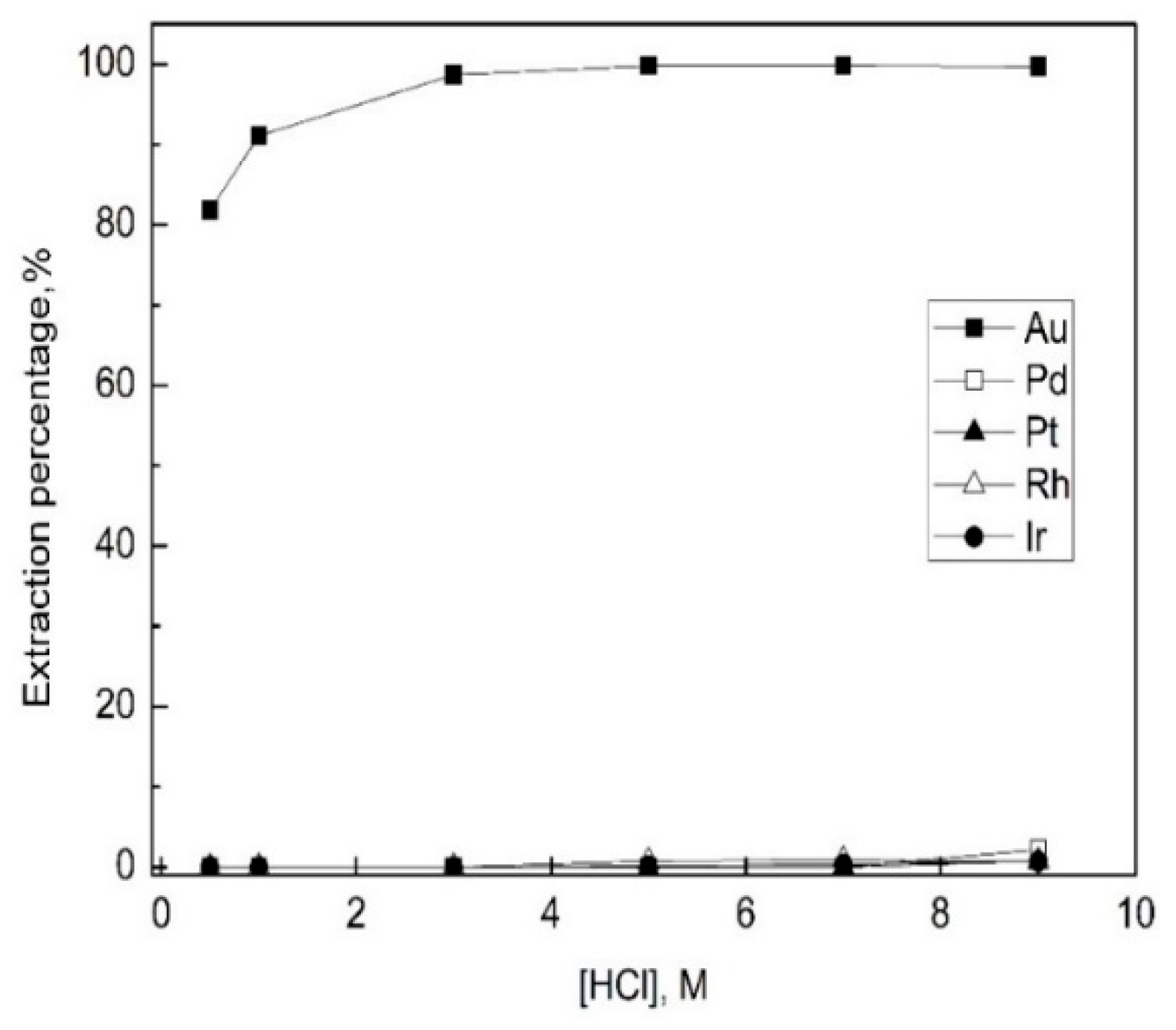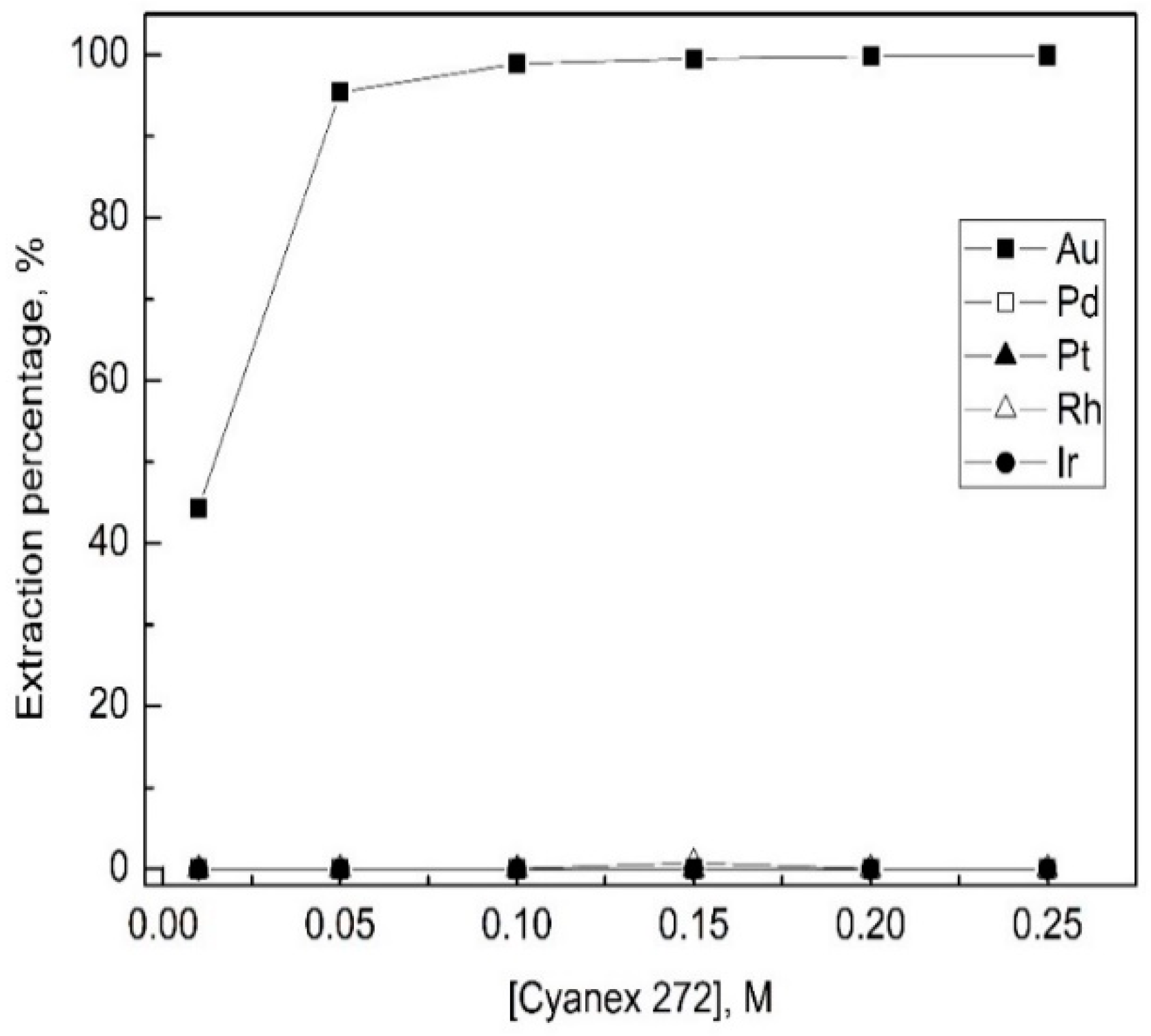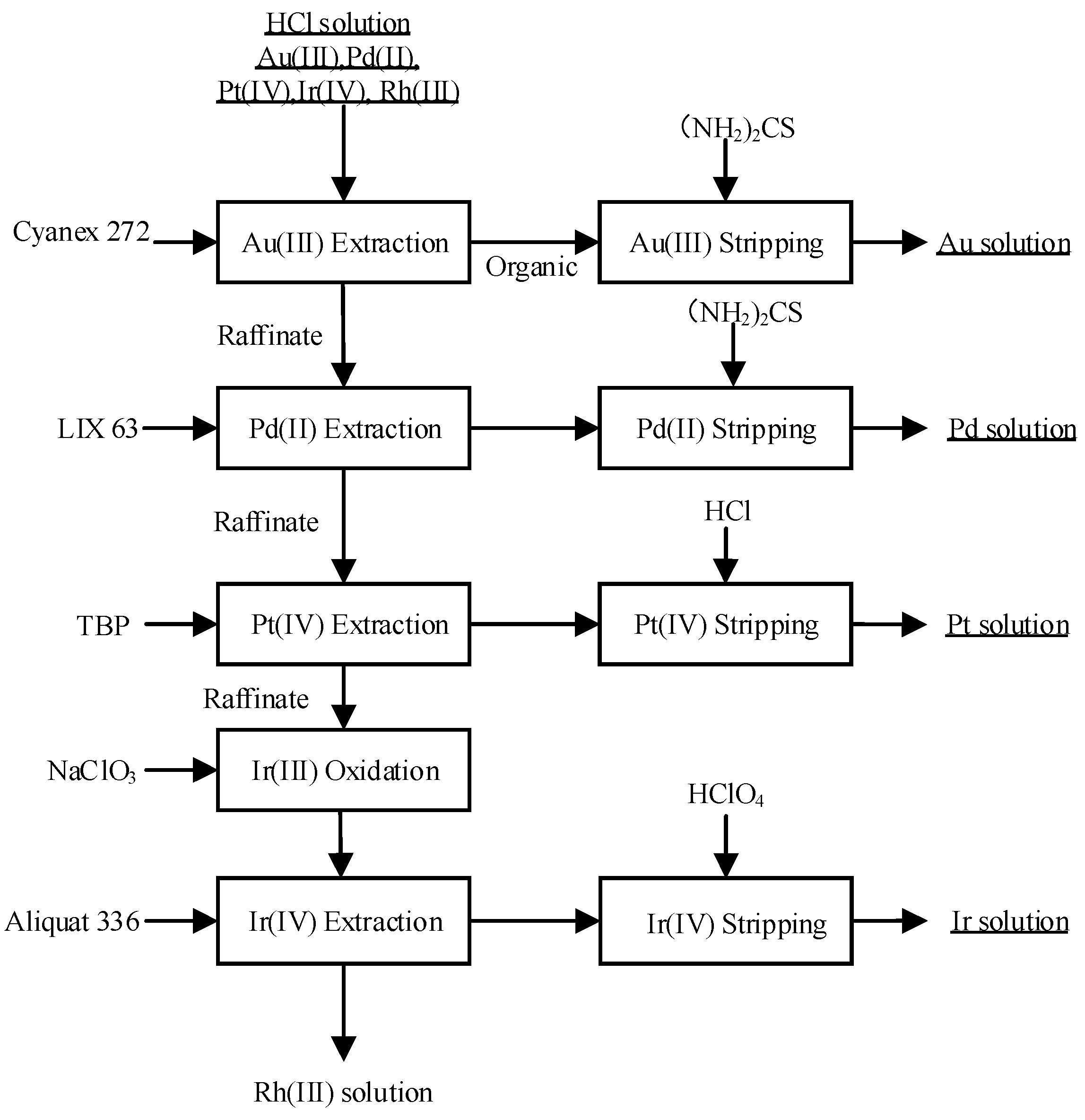A Process for the Separation of Noble Metals from HCl Liquor Containing Gold(III), Palladium(II), Platinum(IV), Rhodium(III), and Iridium(IV) by Solvent Extraction
Abstract
1. Introduction
2. Experimental
2.1. Chemicals and Reagents
2.2. Experimental Process
3. Results and Discussion
3.1. Effect of HCl Concentration on the Extraction Au(III) by Cyanex 272
3.2. Effect of Cyanex 272 Concentration on the Extraction of Au(III)
3.3. Stripping of Au(III) from Loaded Cyanex 272
3.4. Integrated Procedure
4. Conclusions
Author Contributions
Funding
Acknowledgments
Conflicts of Interest
References
- Cui, J.; Zhang, L. Metallurgical recovery of metals from electronic waste: A review. J. Hazard. Mater. 2008, 158, 228–256. [Google Scholar] [CrossRef] [PubMed]
- Zinke, R.K.; Werkheiser, W.H. U.S. Geological survey, mineral commodity summaries; U.S. Geological Survey: Washington, DC, USA, 2018.
- Kononova, O.N.; Melnikov, A.M.; Borisova, T.V. Simultaneous sorption recovery of platinum and rhodium from sulfate–chloride solutions. Hydrometallurgy 2012, 117–118, 101–107. [Google Scholar] [CrossRef]
- Dong, H.; Zhao, J.; Chen, J.; Wu, Y.; Li, B. Recovery of platinum group metals from spent catalysts: A review. Int. J. Miner. Process. 2015, 145, 108–113. [Google Scholar] [CrossRef]
- Syed, S. Recovery of gold from secondary sources—a review. Hydrometallurgy 2012, 115–116, 30–51. [Google Scholar] [CrossRef]
- Snyders, C.A.; Mpinga, C.N.; Bradshaw, S.M.; Akdogan, G.; Eksteen, J.J. The adsorption and elution of platinum group metals (pt, pd, and au) from cyanide leach solutions using activated carbon. In The 5th International Platinum Conference; Glen, H.W., Ed.; The South African Institute of Mining & Metallurgy: Sun City, South Africa, 2013; pp. 743–766. [Google Scholar]
- Shaik, K.; Petersen, J. An investigation of the leaching of pt and pd from cooperite, sperrylite and column bioleached concentrates in thiocyanate-cyanide systems. Hydrometallurgy 2017, 173, 210–217. [Google Scholar] [CrossRef]
- Won, S.W.; Kotte, P.; Wei, W.; Lim, A.; Yun, Y.S. Biosorbents for recovery of precious metals. Bioresour. Technol. 2014, 160, 203–212. [Google Scholar] [CrossRef]
- Coetzee, R.; Dorfling, C.; Bradshaw, S.M. Precipitation of ru, rh and ir with iron ions from synthetic nickel sulphate leach solutions. Hydrometallurgy 2018, 175, 79–92. [Google Scholar] [CrossRef]
- Snyders, C.A.; Bradshaw, S.M.; Akdogan, G.; Eksteen, J.J. Factors affecting the elution of pt, pd and au cyanide from activated carbon. Miner. Eng. 2015, 80, 14–24. [Google Scholar] [CrossRef]
- Snyders, C.A.; Bradshaw, S.M.; Akdogan, G.; Eksteen, J.J. The effect of temperature, cyanide and base metals on the adsorption of pt, pd and au onto activated carbon. Hydrometallurgy 2014, 149, 132–142. [Google Scholar] [CrossRef]
- Nikoloski, A.N.; Ang, K.-L. Review of the application of ion exchange resins for the recovery of platinum-group metals from hydrochloric acid solutions. Miner. Process. Extr. Metall. Rev. 2013, 35, 369–389. [Google Scholar] [CrossRef]
- Hubicki, Z.; Wawrzkiewicz, M.; Wójcik, G.; Kolodynska, D.; Wolowicz, A. Ion Exchange Method for Removal and Separation of Noble Metal Ions; InTech Open Access Publishers: Rijeka, Croatia, 2015. [Google Scholar]
- Cieszynska, A.; Wieczorek, D. Extraction and separation of palladium(ii), platinum(iv), gold(iii) and rhodium(iii) using piperidine-based extractants. Hydrometallurgy 2018, 175, 359–366. [Google Scholar] [CrossRef]
- Yan, Y.; Wang, Q.; Xiang, Z.; Yang, Y. Separation of pt(iv), pd(ii), ru(iii), and rh(iii) from chloride medium using liquid–liquid extraction with mixed imidazolium-based ionic liquids. Sep. Sci. Technol. 2018, 53, 2064–2073. [Google Scholar] [CrossRef]
- Goralska, E.; Coll, M.T.; Fortuny, A.; Kedari, C.S.; Sastre, A.M. Studies on the selective separation of ir(iv), ru(iii) and rh(iii) from chloride solutions using alamine 336 in kerosene. Solvent Extr. Ion Exch. 2007, 25, 65–77. [Google Scholar] [CrossRef]
- Cho, Y.; Lee, J.; So, H.; Ahn, J.; Kim, H.; Lee, J. Comparison of the extraction and separation behavior of la, ce, pr, nd, sm from light rare earth mixed solutions by pc88a and cyanex 572. Korean J. Met. Mater. 2018, 56. [Google Scholar]
- Rzelewska-Piekut, M.; Regel-Rosocka, M. Separation of pt(iv), pd(ii), ru(iii) and rh(iii) from model chloride solutions by liquid-liquid extraction with phosphonium ionic liquids. Sep. Purif. Technol. 2019, 212, 791–801. [Google Scholar] [CrossRef]
- Firmansyah, M.L.; Kubota, F.; Goto, M. Solvent extraction of pt(iv), pd(ii), and rh(iii) with the ionic liquid trioctyl(dodecyl) phosphonium chloride. J. Chem. Technol. Biotechnol. 2018, 93, 1714–1721. [Google Scholar] [CrossRef]
- Oh, C.; Lee, M. Solvent extraction of tb(iii) from hydrochloric acid solution with cyanex 272, its mixture and ionic liquid. Korean J. Met. Mater. 2018, 56, 870–877. [Google Scholar] [CrossRef]
- Xing, W.; Lee, M. Chemical leaching of silver from diverse resources. J. Korean Inst. Resour. Recycl. 2017, 26, 3–10. [Google Scholar]
- Syed, S. Silver recovery aqueous techniques from diverse sources: Hydrometallurgy in recycling. Waste Manag. 2016, 50, 234–256. [Google Scholar] [CrossRef]
- Makishima, A.; Nakanishi, M.; Nakamura, E. A group separation method for ruthenium, palladium, rhenium, osmium, iridium, and platinum using their bromo complexes and an anion exchange resin. Anal. Chem. 2001, 73, 5240–5246. [Google Scholar] [CrossRef]
- Swain, P.; Mallika, C.; Srinivasan, R.; Mudali, U.K.; Natarajan, R. Separation and recovery of ruthenium: A review. J. Radioanal. Nucl. Chem. 2013, 298, 781–796. [Google Scholar] [CrossRef]
- Nguyen, T.H.; Lee, M.S. Effect of hcl concentration on the oxidation of lix 63 and the subsequent separation of pd(ii), pt(iv), ir(iv) and rh(iii) by solvent extraction. Korean J. Met. Mater. 2016, 54, 768–774. [Google Scholar]
- Nguyen, T.H.; Sonu, C.H.; Lee, M.S. Separation of platinum(iv) and palladium(ii) from concentrated hydrochloric acid solutions by mixtures of amines with neutral extractants. J. Ind. Eng. Chem. 2015, 32, 238–245. [Google Scholar] [CrossRef]
- Nikoloski, A.N.; Ang, K.-L.; Li, D. Recovery of platinum, palladium and rhodium from acidic chloride leach solution using ion exchange resins. Hydrometallurgy 2015, 152, 20–32. [Google Scholar] [CrossRef]
- Nguyen, T.H.; Sonu, C.H.; Lee, M.S. Separation of pt(iv), pd(ii), rh(iii) and ir(iv) from concentrated hydrochloric acid solutions by solvent extraction. Hydrometallurgy 2016, 164, 71–77. [Google Scholar] [CrossRef]
- Xing, W.; Lee, M.; Kim, Y. Separation of gold(iii) from hydrochloric acid solution containing platinum(iv) and palladium(ii) by solvent extraction with cyanex 272 and lix 63. J. Ind. Eng. Chem. 2018, 59, 328–334. [Google Scholar] [CrossRef]
- Nagai, H.; Shibata, E.; Nakamura, T. Development of methods for concentration and dissolution of rh and ru from copper slime. Hydrometallurgy 2017, 169, 282–289. [Google Scholar] [CrossRef]
- Xing, W.; Lee, M.; Senanayake, G. Recovery of metals from chloride leach solutions of anode slimes by solvent extraction. Part i: Recovery of gold with cyanex 272. Hydrometallurgy 2018, 180, 58–64. [Google Scholar] [CrossRef]
- Nguyen, V.T.; Lee, J.c.; Jeong, J.k.; Kim, B.S.; Cote, G.; Chagnes, A. Extraction of gold(iii) from acidic chloride media using phosphonium-based ionic liquid as an anion exchanger. Ind. Eng. Chem. Res. 2015, 54, 1350–1358. [Google Scholar] [CrossRef]
- Wei, W.; Cho, C.W.; Kim, S.; Song, M.H.; Bediako, J.K.; Yun, Y.S. Selective recovery of au(iii), pt(iv), and pd(ii) from aqueous solutions by liquid–liquid extraction using ionic liquid aliquat-336. J. Mol. Liq. 2016, 216, 18–24. [Google Scholar] [CrossRef]
- Majavu, A.; Tshentu, Z.R. Separation of rhodium(iii) and iridium(iv) chlorido species by quaternary diammonium centres hosted on silica microparticles. J. South. Afr. Inst. Min. Metall. 2017, 24, 82–94. [Google Scholar] [CrossRef]
- Chavan, D.V.; Dhadke, P.M. Extraction separation of ir(iii) and rh(iii) with cyanex 923 from chloride media: A possible recovery from spent autocatalysts. J. Chem. Technol. Biotechnol. 2002, 77, 925–932. [Google Scholar] [CrossRef]
- Dimitrijević, S.; Rajčić-Vujasinović, M.; Trujić, V. Non-cyanide electrolytes for gold plating – a review. Int. J. Electrochem. Sci. 2013, 8, 6620–6646. [Google Scholar]




| Process | Detail | Au(III) | Pd(II) | Pt(IV) | Ir(IV) | Rh(III) |
|---|---|---|---|---|---|---|
| Feed solution | Synthetic solution, 5 M HCl, mg/L | 100 | 100 | 100 | 100 | 100 |
| Au(III) separation | Extraction: 0.2 M Cyanex 272, O/A = 1, % | 99.9 | / | / | / | / |
| Stripping: 0.3 M (NH2)2CS, A/O = 1, % | 99.9 | / | / | / | / | |
| Raffinate, mg/L | 0.01 | 100 | 100 | 100 | 100 | |
| Pd(III) separation | Extraction: 0.05 M LIX63, O/A = 1, % | / | 95.7 | 0 | 0 | 0 |
| Stripping: 0.1 M (NH2)2CS, A/O = 1, % | / | 99.9 | / | / | / | |
| Raffinate, mg/L | / | 6.05 | 100 | 100 | 100 | |
| Pt(IV) separation | Extraction: 2 M TBP, O/A = 1, 2 stages % | 0 | 0 | 98.6 | 0 | 1.95 |
| Stripping: 0.01 M HCl, O/A = 1, 3 stages, % | / | / | 95.7 | / | / | |
| Raffinate, mg/L | / | / | 1.3 | 100 | 100 | |
| Ir(IV) separation | Extraction: 0.03 M Aliquat 336, 5% TBP, O/A = 1, % | / | / | / | 98.1 | / |
| Stripping: 0.3 M HClO4, A/O = 1, % | / | / | / | 99.9 | / | |
| Raffinate, mg/L | / | / | / | 5.7 | 100 | |
| Results | Extraction percentage, % | 99.9 | 99.8 1 | 98.6 1 | 98.1 1 | 99.9 |
| Stripping percentage, % | 99.9 | 99.9 | 95.7 1 | 99.9 | 99.9 | |
| Recovery, % | 99.8 | 99.7 | 94.4 | 98.1 | 99.9 |
© 2019 by the authors. Licensee MDPI, Basel, Switzerland. This article is an open access article distributed under the terms and conditions of the Creative Commons Attribution (CC BY) license (http://creativecommons.org/licenses/by/4.0/).
Share and Cite
Xing, W.D.; Lee, M.S. A Process for the Separation of Noble Metals from HCl Liquor Containing Gold(III), Palladium(II), Platinum(IV), Rhodium(III), and Iridium(IV) by Solvent Extraction. Processes 2019, 7, 243. https://doi.org/10.3390/pr7050243
Xing WD, Lee MS. A Process for the Separation of Noble Metals from HCl Liquor Containing Gold(III), Palladium(II), Platinum(IV), Rhodium(III), and Iridium(IV) by Solvent Extraction. Processes. 2019; 7(5):243. https://doi.org/10.3390/pr7050243
Chicago/Turabian StyleXing, Wei Dong, and Man Seung Lee. 2019. "A Process for the Separation of Noble Metals from HCl Liquor Containing Gold(III), Palladium(II), Platinum(IV), Rhodium(III), and Iridium(IV) by Solvent Extraction" Processes 7, no. 5: 243. https://doi.org/10.3390/pr7050243
APA StyleXing, W. D., & Lee, M. S. (2019). A Process for the Separation of Noble Metals from HCl Liquor Containing Gold(III), Palladium(II), Platinum(IV), Rhodium(III), and Iridium(IV) by Solvent Extraction. Processes, 7(5), 243. https://doi.org/10.3390/pr7050243






